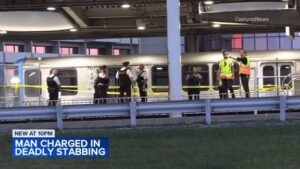Lawrence Strother: Jason Rowinski Chicago,Rosemont CTA stabbing,Line incident

Strother was arrested he was arrested around 10:30 p.m. wednesday. Today we will discuss about Lawrence Strother: Jason Rowinski Chicago,Rosemont CTA stabbing,Line incident
Lawrence Strother: Jason Rowinski Chicago,Rosemont CTA stabbing,Line incident
On June 25, 2025, a normal evening commute on the Chicago Transit Authority’s Blue Line turned into a shocking tragedy. The incident involved 66-year-old Lawrence Strother, a resident of Broadview, Illinois, and 42-year-old Jason Rowinski. What began as a verbal disagreement on a train ended with Rowinski fatally stabbed near the Rosemont station.
This event, which unfolded between O’Hare International Airport and downtown Chicago, has become a case study in urban transit safety, police coordination, and public awareness. The incident not only raised serious questions about violence in public spaces but also reignited debate about security on public transport systems across the United States.
Who is Lawrence Strother?

Lawrence Strother, age 66, lived on Summerdale Drive in Broadview, Illinois. Public records and media reports describe him as an older suburban man with no widely reported criminal history prior to the event.
On that evening, Strother boarded an inbound CTA Blue Line train heading toward downtown Chicago. During the ride, witnesses observed an argument between him and another passenger — later identified as Jason Rowinski. Within moments, the confrontation turned violent.
Police later confirmed that Strother stabbed Rowinski once in the thigh area with a knife, causing severe bleeding. Despite emergency response efforts, the wound proved fatal. Strother attempted to flee but was soon arrested by suburban police near Rosemont after trying to board a shopping-mall shuttle bus.
He was charged with first-degree murder and taken into custody by the Chicago Police Department.
The Victim: Jason Rowinski
Jason Rowinski, aged 42, was identified by the Cook County Medical Examiner’s Office as the victim of the fatal stabbing. Limited details about Rowinski’s personal life have been made public out of respect for his family’s privacy. Reports describe him as a regular commuter who happened to be traveling on the Blue Line that night.
Friends and relatives remember him as a friendly and responsible man who enjoyed simple routines and commuting through Chicago’s public transit. His unexpected and violent death sent shockwaves through his community and drew widespread sympathy from local residents.
Timeline of the Rosemont CTA Stabbing
Evening of June 25, 2025
At approximately 7:45 p.m., passengers on the inbound Blue Line train reported a heated argument between two men. Witnesses later identified them as Lawrence Strother and Jason Rowinski.
The altercation reportedly began over a minor disagreement — some passengers described it as a verbal exchange that quickly escalated.
The Fatal Moment
During the argument, Strother drew a knife and stabbed Rowinski once in the thigh or knee area. Though the wound may not initially have appeared life-threatening, it caused rapid blood loss and severe trauma. Other passengers immediately alerted the train operator and emergency services.
Emergency Response
Paramedics met the train as it arrived near the Rosemont station. Rowinski was rushed to Advocate Lutheran General Hospital in Park Ridge but succumbed to his injuries shortly after arrival. The entire sequence — from the argument to the victim’s death — unfolded within roughly 30 minutes.
The Escape Attempt and Arrest
After the stabbing, Strother exited the train at Rosemont station and boarded a shuttle bus headed toward a nearby shopping mall. Rosemont police, who had been alerted by CTA officials, quickly tracked him down and arrested him before he could leave the area.
He was later transferred into Chicago Police custody and charged with first-degree murder. Authorities also recovered the knife believed to have been used in the attack.
Charges and Legal Proceedings
Lawrence Strother faces a charge of first-degree murder, one of the most serious criminal offenses in Illinois. The charge indicates that prosecutors believe the act was intentional and without legal justification.
If convicted, Strother could face a lengthy prison sentence, possibly life imprisonment without parole, depending on the evidence and court rulings.
At present, public records indicate that Strother remains in custody awaiting trial. The Cook County State’s Attorney’s Office has not yet released detailed information about the defense’s claims or any mental-health assessments that may be part of the case.
Given Strother’s age, the legal process could also include considerations of mental health, capacity, or intent. The court proceedings are expected to draw significant media attention due to the unusual nature of the crime and the setting in a busy public transit system.
A Closer Look at the CTA Blue Line
The CTA Blue Line is one of Chicago’s busiest transit routes. It connects O’Hare International Airport to downtown and the city’s western neighborhoods, extending through suburban areas such as Rosemont.
Millions of commuters, tourists, and airport workers rely on it every month. Despite this high volume of traffic, fatal violent incidents on the CTA are relatively rare. When they do occur, however, they raise widespread alarm and highlight systemic concerns about passenger safety.
The Blue Line operates both above and below ground, often with long stretches between stations. In such settings, passengers are confined in close quarters with limited means to exit or call for immediate help — conditions that can quickly turn dangerous when tempers flare.
Transit Safety Concerns
1. Confined Spaces
Trains create an enclosed environment where passengers have little room to move or escape during an emergency. Once an altercation begins, it can escalate rapidly before anyone has time to react.
2. Limited Security Presence
Although the CTA deploys transit police and security cameras, there are often few or no uniformed officers present inside the train cars themselves. This limits the ability to prevent or immediately respond to violence.
3. Emergency Response Challenges
Even when witnesses act quickly, emergency responders may need several minutes to reach a train in motion. This time gap can be critical, particularly in cases involving severe injuries such as stab wounds.
4. Jurisdictional Boundaries
The Blue Line crosses multiple jurisdictions, including city and suburban territories. Coordinating between the Chicago Police Department, suburban law enforcement, and the CTA can be complex, especially when incidents occur near border stations like Rosemont.
5. Public Confidence
Every violent event erodes public confidence in transit safety. Commuters may feel less secure and consider alternative travel options, affecting the overall usage of public transportation.
Community and Public Reaction
The incident prompted widespread outrage and concern across Chicago and its suburbs. Passengers expressed shock that such violence could occur in a public, monitored environment.
Community leaders called for increased police patrols on CTA trains and platforms, especially along the Blue Line, which serves airport routes and late-night travelers.
Many passengers and commuters have urged transit authorities to introduce more security officers, improved surveillance systems, and clearer communication channels for emergencies.
Vigils and memorials were organized for Jason Rowinski, with friends and family calling for justice and stronger protection for everyday commuters.
The Broader Problem: Violence in Public Transit
Incidents like the Rosemont CTA stabbing are not isolated. Across the U.S., several major cities have faced challenges involving crime and violence on public transportation systems.
Experts point to a combination of factors:
-
Mental health crises among riders.
-
Economic stress and homelessness affecting transit systems.
-
Limited funding for security upgrades and patrols.
-
Lack of consistent law-enforcement coordination between transit agencies and municipal police.
While CTA has made improvements in recent years, this case underscores the continuing need for proactive safety measures — not just reactive enforcement.
Possible Policy Changes Ahead
In response to incidents like this, transit authorities and city officials may consider several policy changes:
-
Increased Police Visibility
Deploying uniformed officers or transit security on more train cars, especially during high-risk hours. -
Enhanced Surveillance Systems
Expanding camera coverage and real-time monitoring to identify potential threats early. -
Emergency Alert Buttons
Installing easy-to-use emergency call buttons or intercoms inside train cars so passengers can contact operators instantly. -
Public Awareness Campaigns
Educating commuters on how to safely report suspicious or violent behavior through anonymous channels. -
Coordination Between Jurisdictions
Creating faster communication between suburban police departments and the Chicago Police to handle cross-boundary emergencies efficiently. -
Mental-Health Support
Introducing programs to help individuals struggling with emotional or psychological challenges before such issues escalate into violence.
Legal and Social Implications
From a legal perspective, this case will likely explore questions about intent, provocation, and mental state. Defense attorneys could argue self-defense or diminished capacity, although available reports suggest Strother acted aggressively and attempted to flee afterward — both factors that may weaken such claims.
Socially, the case highlights how stress, isolation, and societal tension can contribute to public altercations. For an older individual like Strother, this may reflect deeper issues of anger, frustration, or declining mental stability.
The outcome of this case could set a precedent for how Chicago prosecutors handle similar public-transit crimes and how courts weigh age and mental health in sentencing decisions.
Impact on the Chicago Transit Authority
For the CTA, this tragic incident has forced renewed evaluation of passenger safety protocols. The agency has historically relied on surveillance and emergency communication systems, but those alone may not be enough to prevent spontaneous acts of violence.
The incident underscores the need for:
-
Rapid communication between train operators and emergency responders.
-
Clearer signage instructing passengers how to report violence.
-
Stronger partnerships between CTA security and local police departments.
Transit unions have also voiced concerns about employee safety, calling for more protective barriers for train conductors and security presence during late-night shifts.
Public Trust and Psychological Effects
Violent incidents on public transit not only claim lives but also damage public trust. Many commuters, particularly women, seniors, and night-shift workers, may feel unsafe using trains after dark.
Psychologically, such events can lead to long-term anxiety among passengers, who may become hyper-vigilant or avoid transit altogether. Rebuilding this confidence requires consistent safety measures, transparency from authorities, and visible improvements in day-to-day security.
Human Side of the Tragedy
While much of the public focus rests on the crime and its legal consequences, it’s essential to remember the human impact. Jason Rowinski’s family lost a loved one without warning.
His death underscores the fragility of life and how quickly ordinary situations can turn tragic. The emotional weight of such a loss is immeasurable — a reminder that every violent act ripples through families, communities, and cities.
For Lawrence Strother, the legal process ahead will determine accountability. Whatever his motives or mental state, the choices he made that night changed two lives forever.
What Comes Next
As of now, the case against Strother continues through the Illinois court system. Prosecutors are preparing evidence, and the defense has yet to disclose its full argument. The court will decide whether the act was premeditated or arose from sudden provocation.
The broader community watches closely — not only for justice for Jason Rowinski but also for signs of meaningful change in how Chicago ensures safety across its vast transit network.
Conclusion
The Lawrence Strother case represents more than a single tragic event; it’s a reflection of deeper issues affecting urban life, public safety, and mental health. It shows how quickly everyday tensions can explode into irreversible violence — even in places meant to be safe for everyone.
For Chicago, the tragedy is both a warning and a lesson. It underscores the importance of vigilance, compassion, and preparedness in all public spaces.
As the city mourns the loss of Jason Rowinski and awaits the court’s judgment, the hope remains that his death will lead to stronger systems, better awareness, and a safer transit experience for millions who ride the CTA every day.
How useful was this post?
Click on a star to rate it!
Average rating 0 / 5. Vote count: 0
No votes so far! Be the first to rate this post.
About the Author
usa5911.com
Administrator
Hi, I’m Gurdeep Singh, a professional content writer from India with over 3 years of experience in the field. I specialize in covering U.S. politics, delivering timely and engaging content tailored specifically for an American audience. Along with my dedicated team, we track and report on all the latest political trends, news, and in-depth analysis shaping the United States today. Our goal is to provide clear, factual, and compelling content that keeps readers informed and engaged with the ever-changing political landscape.



